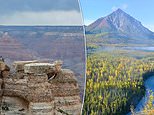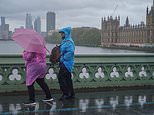
A recent study indicated that more than 300 million Americans visited a national park in 2023.
Some visitors to national parks can be spotted doing activities like hiking or rock climbing, while others may be taking pictures of scenic views.
However, a variety of things can go wrong when visiting a national park that can cause serious injuries…or even death.
Outdoor clothing brand KUHL released a list of the top 10 deadliest national parks on January 23 after looking into data associated with things like deaths, missing people, and search and rescue missions.
So, just what are the 10 deadliest national parks and the frightening risks that individuals face when visiting these locations?
10. Mount Rainer National Park
Mount Rainer National Park is located in Ashford, Washington and has a death probability rate of one in 317,000
Mount Rainer National Park in Ashford, Washington has massive glaciers, wildflowers in its subalpine meadows, and a death probability rate of one in 317,000.
According to the KÜHL’s data, 69 individuals have died between 2007-2023 and the National Park Service (NPS) found that more than 400 people have died in the park since the government began keeping records.
One of the things Mount Rainer is also known for is its massive and active volcano.
The volcano’s last eruptive period occurred about 1,000 years ago, but it’s still a risky area for individuals who love rock climbing.
The NPS even concluded that 25 percent of the Mount Rainer National Park deaths occurred due to rock climbing incidents.
Interestingly enough, KÜHL found that 20.3 percent of deaths occur from falls while 0.9 percent of fatalities are due to rockfall.
9. Guadalupe Mountains National Park
Guadalupe Mountains National Park in Salt Flat, Texas have more than 80 miles of hiking trails available to individuals who visit the park
Salt Flat, Texas is the home of the Guadalupe Mountains National Park, an area with more than 80 miles of hiking trails.
It does also have a death probability rate of one in 514,000, which is a bit worse than Mount Rainer National Park.
The park, while a popular tourist attraction, comes with a variety of risks that individuals should pay attention to, hikers especially.
Things that are important to remember when at the park is that sudden weather changes are common and to avoid exposure in open areas during storms.
The area is also full of cacti, rattlesnakes, scorpions, and desert centipedes, which can result in a variety of injuries.
8. Kings Canyon National Park
Kings Canyon National Park in California has a one in 220,000 death probability rate. As of 2023, 45 deaths inside the park have occurred
Located in California, Kings Canyon National Park features a one in 220,000 death probability rate.
Between 2007-2023, 45 deaths have occurred inside the park so far.
Things that may be important for visitors to remember is the park’s extreme climate conditions and high elevations that range up to nearly 15,000 feet high.
Because of these conditions, it is not uncommon for hikers to go missing or be in need of rescue in the mountains,
7. Denali National Park
Denali National Park receives around 600,000 visitors every year despite having a one in 119,000 death probability rate
Denali is one of two national parks in Alaska that is on the top 10 of this list.
The park receives around 600,000 visitors every year despite having a one in 119,000 death probability rate.
Denali National Park already has 64 reported fatalities of individuals in the park between 2007-2023.
The area is relatively safe, but some of the biggest dangers in the park include steep cliffs, deep crevasses, and unstable rocks.
These conditions, combined with freezing temperatures, can potentially making hiking and rock climbing extremely dangerous.
6. Big Bend National Park
Big Bend National Park receives more than 500,000 annual visitors every year and has a 1 in 218,000 death probability rate. Only 31 deaths have occurred in the park between 2007-2023
Receiving more than 500,000 visitors every year, Big Bend National Park in Panther Junction Texas is full of rivers, dirt roads, and a 1 in 218,000 death probability rate.
Big Bend National Park is a risky place to go due to extreme heat and flash flooding.
Only 31 deaths have occurred at this national park between 2007-2023, which is fewer than multiple parks featured on this list.
However, cell phone service is spotty throughout the park, and hikers have spotted venomous creatures like scorpions and rattlesnakes.
5. Dry Tortugas National Park
Dry Tortugas National Park in Homestead, Florida does have a wide variety of ocean life, but visitors also have a one in 184,000 chance of dying there
This national park in Homestead, Florida does have a wide variety of ocean life, but visitors also have a one in 184,000 chance of dying there.
The park is located off the coast of Key West and can only be accessed by boat or sea plane.
Although it has an abundance of water, the land itself poses threats to hikers or anyone just visiting the island.
Besides the incredibly hot and humid weather, there are risks of lightening strikes, poisonous snakes, and spiders.
Individuals in land or in the water should also be on the lookout for alligators.
4. North Cascades National Park
The North Cascades National Park in Washing comes with scenic views and a high death probability rate of one in 18,000
The North Cascades National Park in Washing comes with scenic views and a high death probability rate of one in 18,000.
Like Mount Rainer National Park, hikers and rock climbers face deadly risks when visiting the park.
Big issues to watch out for when visiting the park include terrible weather and an unstable landscape magnified by climate change.
This Washington park witnessed 24 in-park deaths between 2007-2023, but it’s still important for individuals to remember the risks.
3. Isle Royale National Park
The remote island in Michigan has a death probability rate on one in 163,000 and is home to animals such as moose, wolves, and foxes
This remote island cluster in Michigan has a death probability rate of one in 163,000 and is home to a variety of animals that pose a risk to fatalities.
Moose, wolves, and foxes have been spotted occasionally in this park and all can be vicious if they feel a human poses a risk to their safety.
However, the area is a popular place to visit in Michigan, and there are a good amount of ranger stations just in case anyone needs help.
Other than animals, individuals should lookout for the rocky and hilly terrain of the island, which can be difficult for hikers.
2. Wrangell-St. Elias National Park
The Wrangell-St. Elias National Park in south central Alaska had nearly 65,000 visitors in 2022 and currently has a one in 126,000 death probability rate within the area
Located in south central Alaska, this national park had nearly 65,000 visitors in 2022 and a one in 126,000 death probability rate within the area.
Not only does it have large glaciers, but the park is also home the Wrangell Volcanic Field that covers more than 2,000 square miles of the park.
A major risk for hikers who go to this park is the low visibility, especially for individuals who prefer to hike at night.
Suggestions to be at a much lower risk of any fatality in the park at night are for visitors to stay on trails, stay in groups, and carry bear spray.
According to KÜHL, nine people have died between 2007-2023.
1. Grand Canyon National Park
The Grand Canyon is one of America’s most visited tourist attractions…but is also famously dangerous for anyone who chooses to venture off authorized pathways
The Grand Canyon National Park in Arizona is a popular worldwide tourist destination that receives millions of visitors every year.
One in 503,000 individuals has a chance of dying in the park and 165 individuals alone died between 2007-2023.
Some of the biggest things that can occur if visitors aren’t too careful are dehydration and heat strokes due to the extremely hot weather.
Other things to watch out for include wild animals, flash floods, and viewpoints.
According to Grand Canyon National Park Trips, every year visitors fall to their deaths in the Grand Canyon.
Source link
CHECK OUT: Top Travel Destinations
READ MORE: Travel News



